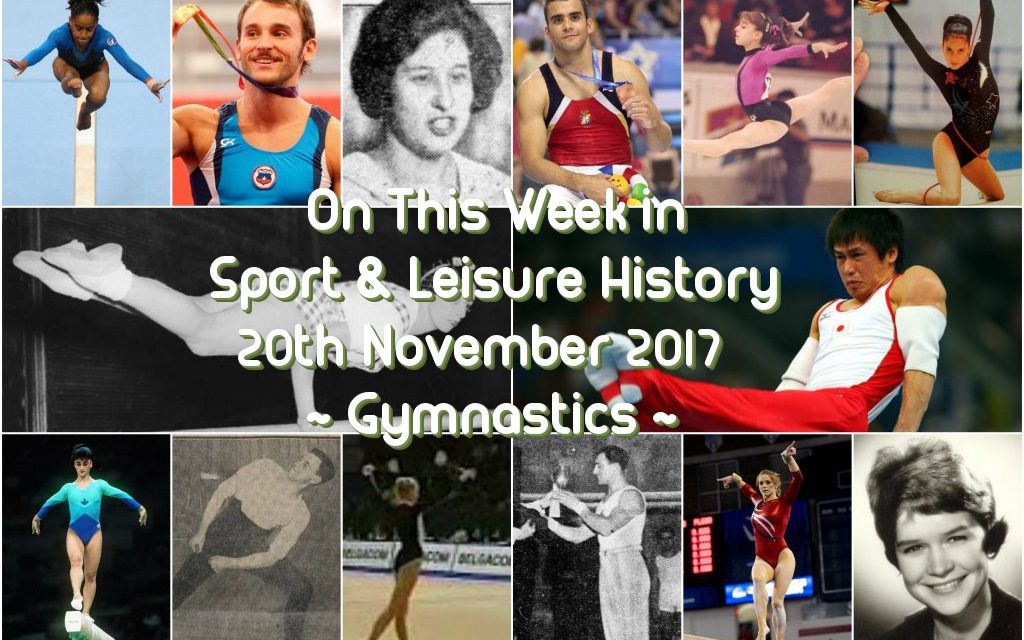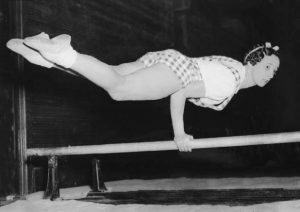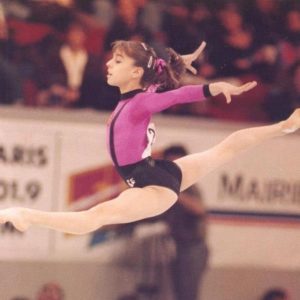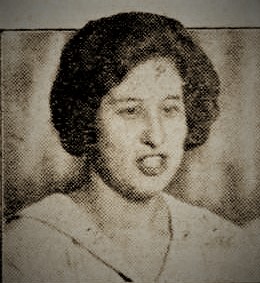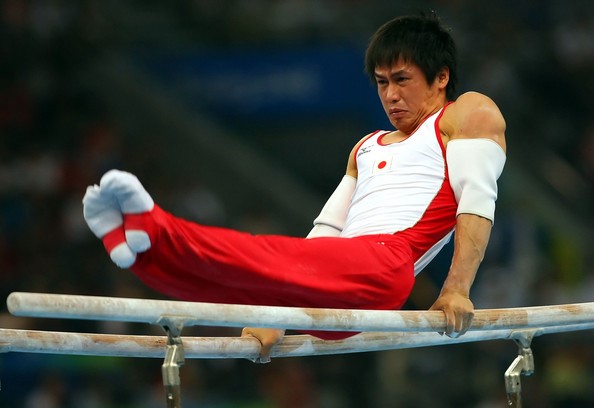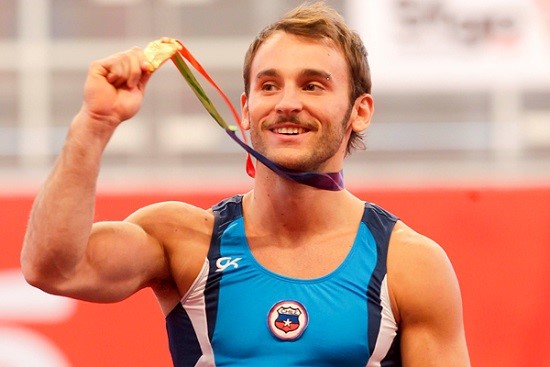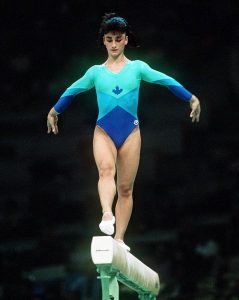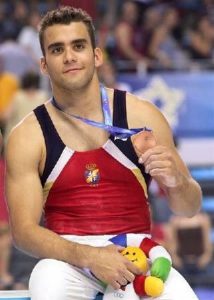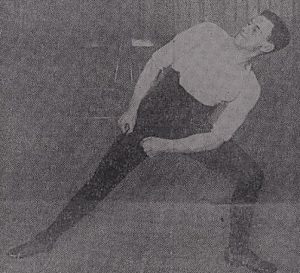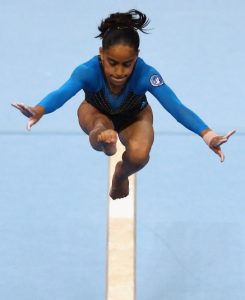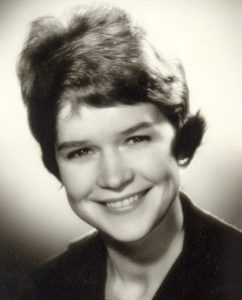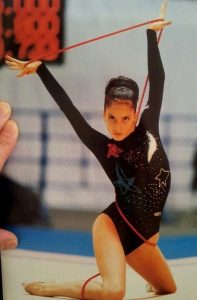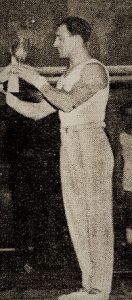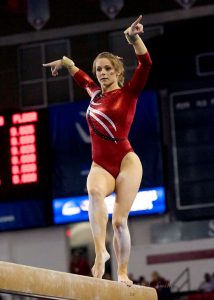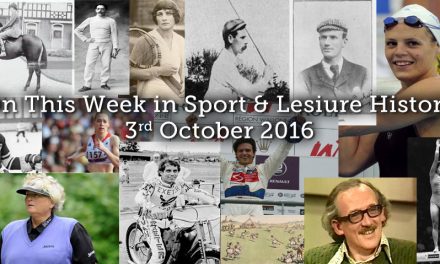20th-Swiss gymnast Water Beck was born on this day in 1907. He won silver in the Men’s All-Around competition at the 1936 Olympic Games. Born in 1908, American gymnast Irma Haubold, nee Pezzia who competed at the 1936 Games, coming 5th with the team, the only women’s gymnastics event at those Olympics. She was married to a fellow Olympic gold medal gymnast Frank Haubold. They were the first married couple to compete in the same Olympics Games. She died at the age of 87 on 4th April 1996. French gymnastics competitor Madeleine Jouffroy was born on this day in 1927. She competed at the 1952 Olympics in Helsinki. Born on this day 1949 British gymnast Edward Randall “Eddie” Arnold. Born in Moston, Manchester he attended Carnegie College between 1969-1973 and studied for a Masters degree at Leeds University. He trained at the Leeds Athletic Institute with the likes of Dick Gradley and Scott Mackie. He represented GB at the 1972 Munich Olympics along with team mates Stan Wild and Bill Norgrave. He was killed in 2000 in a climbing accident. Belarusian Antonina Koshel, born in 1954, competed for Russia at the 1972 Olympics winning a gold medal in the team All-Around competition. Individually her best achievement was 12th place on the beam and vault. Koshel began gymnastics after following her older sister, Natalia, into the gym. However, she preferred ballet over gymnastics, but she was not accepted into a local ballet school. After that, she moved to the Minsk sports boarding school to train in gymnastics. She returned to Smalyavichy when her family had trouble paying for the school. However, her coach Viktor Khomutov persuaded Koshel’s parents to let her stay in Minsk. She caught the eye of the national team coaches after winning the all-around competition at the 1970 All-Union Youth Championships. She was invited to join the national team after the 1971 Riga International. Out of the twenty-four possible choices, Koshel was one of the seven women chosen to represent the in Munich. Koshel retired from gymnastics in 1974, and she now works as a coach in Minsk. Austrian rhythmic gymnast Elisabeth Bergmann was born today in 1970. She competed for Austria in the at the 1988 Summer Olympics in Seoul, where she was 25th in the preliminary round, not advancing to the final. Dominique Dawes-Thompson, American gymnast was born in 1976. Known in the gymnastics world as ‘Awesome Dawesome,’ she was a 10-year member of the US national gymnastics team, the 1994 U.S. all-around senior National Champion, a three-time Olympian, a World Championship silver and bronze medallist, and a member of the gold-medal-winning team “Magnificent Seven” at the 1996 Summer Olympics in Atlanta. Dawes is also notable as being the first African-American woman to win an individual Olympic medal in artistic gymnastics, and the first black person of any nationality or gender to win an Olympic-gold-medal in gymnastics. She is also one of only three female American gymnasts, along with Muriel Grossfeld and Linda Metheny-Mulvihill, to compete in three Olympics and was part of their medal-winning teams: Barcelona 1992 (bronze), Atlanta 1996 (gold), and Sydney 2000 (bronze). Dawes is the first female gymnast to be a part of three Olympic-medal-winning teams since Lyudmila Turischeva won gold in Mexico City (1968), Munich (1972), and Montreal (1976). Since Dawes, Svetlana Khorkina is the only gymnast to accomplish this feat, winning silver in Atlanta (1996) and Sydney (2000), and bronze in Athens (2004).
Sonia Fraguas, Spanish gymnast, was born in 1977. An Olympian of the 1992 Barcelona Games where she was placed 9th in the Individual All-Around and the Spanish team was 5th overall in the team competition. Her older sister Cristina was also a member of that team and she came 13th in the Individual All-Around competition.
- Irma Haubold
- Sonia Fraguas
21st-French secondary school teacher and international gymnast Pierre Edmond Paysse was born on this day in 1873. He competed at the 1900 Olympics and 1906 Intercalated Games – placing 4th in the individual All-Around competition in 1900 and winning 2 golds in 1906 – in the individual All-Around and the All-Around (5 events competition). At the 1903 World Gymnastics Championships he won the gold for the all-around team and an individual silver in the bar. Two year later at the 1905 Championships he again was a team gold medallist and took home two bronzes on bat and parallel bars. He was also horizontal bar world champion in 1906 and in 1917 was instrumental in women’s football in France. As gymnastics teacher to two boys’ secondary schools, he recognised that the girls’ football teams from Femina Sport had little opposition and arranged for mixed matches to be played. A remarkable achievement in 1917 when non-mixing was not only a rule in school but in society in general. The contests ended after six months however as French federation of athletics (Union des Societies Francaises des Sports Athletiques, USFSA), the first amateur multi-sports federation managing about twenty different sports, forbade its member clubs to play football against women’s teams. He died in 1938. Gerardus Jacobus Wesling, Dutch gymnast was born in 1885. He competed in the 1908 Olympics where as part of the Dutch team he finished seventh in the team event and 60th in the individual All-Around, He died on 19th August 1954 in Amsterdam. Born today in 1905 in Amsterdam, Dutch gymnast Elka de Levie, competing for Amsterdam club BATO, she qualified for the Dutch gymnastics team as a reserve. Eventually, she was selected to compete in the first ever women’s gymnastics competition at the 1928 Olympics. The Dutch team earned the gold medal with considerable ease. De Levie’s best known result apart from the Olympics is a first place in the Amsterdam “Steen” competition in 1926. Like a number of her Olympic team- and clubmates, and the team’s coach, De Levie was Jewish, he was the only Jewish team member to survive the Holocaust. Her teammates Anna Dresden-Polak, Jud Simons and Helena Nordheim, along with coach Gerrit Kleerekoper were gassed in Sobibor, while Estella Agsteribbe was gassed in Auschwitz. On 31st October 1929 she married Andries Abraham Boas but the couple were divorced in 1943. She and both her daughters survived the Second World War by going into hiding. Elka de Levie died in anonymity in Amsterdam on 29th December 1979. Japanese Olympian and gymnastics coach Hiroyuki Tomita was born in 1980. Tomita began gymnastics at the age of eight with his mother getting him started into the sport. He made his debut in world championships competition at the 2002 World Championships, where he came 4th in the event finals of rings. The following year, he was a member of the Japanese men’s team which won a bronze in the 2003 World Championships. He also won bronze in the men’s all-around in the same competition, establishing himself as one of Japan’s top male gymnasts, with his star teammate, Naoya Tsukahara, ranking only 7th in the all-around. In his first Olympics, Tomita led the men’s team in an upset when the Japanese team captured the Olympic title for the first time since 1976, winning over the highly favoured Chinese men’s team. Tomita ranked 6th in the all-around and won silver in the parallel bars. The next year, in the 2005 World Championships in Melbourne, Tomita established himself as the top gymnast in the world by claiming the all-around title. His win made him the first Japanese gymnast in 31 years to win the men’s World Championship. The top two spots were contested in the 2008 Olympics between China and Japan, with Japan as the reigning Olympic men’s team gold medallist, and Tomita as the most senior men’s team member, and leader. China’s men’s team won the gold medal with a team total of 286.125, over seven points more than Japan’s total of 278.875, which was only good enough for the silver medal. In a press conference in November 2008, Tomita announced his retirement from the sport. He started his coaching career in 2009, becoming the head coach at Juntendo University. He works with gymnasts like Koki Sakamoto and Yosuke Hoshi. In February 2009, Tomita received official certification allowing him to judge gymnastic competitions. Tasha Schwikert Warren, born today in 1984 is an American gymnast who is a 2000 Olympic bronze medallists, a World Gymnastics Championships team gold medallists, the 2001 and 2002 US senior national all-around champion and the 2005 and 2008 NCAA all-around national champion. Schwikert began gymnastics at a young age and rose through the ranks to the elite level in the sport in the mid-90s. She was a surprise member of the 2000 Olympic squad, but performed well in both the team preliminaries and finals in Sydney. Following the Olympics, she became one of the most prominent gymnasts in the United States, winning two team medals at the World Championships and placing fifth in the all-around at the 2001 Worlds. An ankle injury impeded her progress and left her named as an alternate on the 2004 Olympic team. Following her elite career, Schwikert spent four years as a member of the UCLA Bruins gymnastics team. During her time with the Bruins she won two individual all-around NCAA national champion titles and two Pac-10 all-around titles, and was nominated for the Honda Award. She is currently pursuing a career in broadcast journalism, and has already been employed as a commentator at several major gymnastics events. Krystyna Cherepenina, Ukrainian Rhythmic gymnast was born on this day in 1991. At the 2008 Olympics in Beijing she was placed 8th in the Women’s Group competition. Russian Tatiana Nabieva was born in 1994, in Pushkin, she won four World Championship medals. At the 2010 Japan Cup, she introduced a toe-on laid-out Tkachev on the uneven bars (a piked sole circle backwards to a reverse hecht in a layout position over the high bar). Gold with the Russian team at the 2010 World Championships, despite falling on the uneven bars in the team final. It was at these world championships that her original skill was officially named after her. She also qualified for the all-around final, but errors left her in seventh place. At the 2011 Worlds she won silver as part of the Russian team and a silver in the uneven bars behind teammate Viktoria Komova. In late 2013, Nabieva announced her retirement from gymnastics via social media after a win at a small French meet. She said: “I want to be a coach. That’s my dream, since the very moment I started gymnastics. My dream is to train children and participate with them in the most serious competitions.” She was however persuaded to come out of retirement to compete at the 2014 World, scoring 14.933 on vault, which helped the Russian team win. She finally retired from gymnastics in 2016.
- Elka de Levie
- Hiroyuki Tomita
22nd -Emil Beyer, American from New York city was born today in 1876. A gymnast and track and field athlete who competed in the 1904 Olympics. Born to German immigrant parents, Beyer was a member of the New York Turnverein. In 1904 he won the silver medal in the team event. He was also 30th in gymnastics all-around event, 34th in gymnastics’ triathlon event and 36th in athletics’ triathlon event. He had entered United States Military Academy in 1897, but failed to graduate. In later life, he operated a pharmacy. He died on 15th October 1934. Italian Olympic competitor Paolo Salvi was born on this day in 1891. Salvi was twice a member of the victorious Italian gymnastics squad that took Olympic gold in 1912 and 1920. At the 1911 World Championships, Salvi won silver in pommell horse and bronzes in parallel bars and in team all-around. He was also a member of Italian gymnastics team that won bronze in team all-around at the 1913 World Championships. He later served as a judge. In November 1944, Salvi was arrested for the first time and in 1945 was killed in an unknown German concentration camp, probably Mauthausen. Japanese gymnast Kiichiro Toyama was born in 1909. He competed at the 1936 Olympics in Berlin where his best result was a ninth place finish in the All-Around Team competition. Fourteen teams entered this event, which consisted of eight-man teams, with the top six scores from the individual all-around counting towards the team score. Germany and Switzerland dominated, with Germany winning the gold medal fairly comfortably ahead of the Swiss. Finland was a distant third. Germany was led by Alfred Schwarzmann and Konrad Frey, the gold and bronze medallists in the individual all-around, while Switzerland was led by Eugen Mack, who won silver in that event. Born on this day in 1931, Czech gymnast Alena Chadimová, who competed in the 1952 Olympics, winning a bronze in the women’s All-Around team event. German rhythmic gymnast Christiane Klumpp (now Wagner) was born in Freudenstadt, West Germany in 1976. She competed for Germany in the rhythmic gymnastics all-around competition at the 1992 Olympics in Barcelona, coming 10th overall. Later in the same year, in November, she was 8th in the individual all-around at the World Rhythmic Gymnastics Championships in Brussels. Enrique Tomás González Sepúlveda (known as Tomás González) was born on this day in 1985 in Santiago Chile. He was the first Chilean to win a medal at the Gymnastics World Cup, and the first to qualify for a Summer Olympic Games. González has won nine medals (four golds, four silvers and one bronze) at World Cup events, five medals (three silvers and two bronzes) at Pan American Games, seven medals (two golds, two silvers and three bronzes) at South American Games and one gold medal at the January 2012 London Olympics test event (where he qualified for the Olympics). He has participated in four World Championships (2007, 2009 2010 and 2011), finishing seventh in floor in 2009 and sixth in the same exercise in 2011. In April 2011 González was ranked World Number 1 on floor and vault for the first time. At the 2012 Olympics González finished fourth in the floor and vault finals, with a score of 15.366 (out of 16.500) and 16.183 (out of 16.800), respectively. His execution score of 9.383 in vault was the highest among the eight finalists. Also born on this day in 1985 was Japanese gymnast Makoto Okiguchi. He was part of his national team that won team silver at the 2007 and 2011 World championships as well as an Olympic team silver at the 2009 Games. He has one individual international medal – a bronze in the vault at the 2011 World Championships.
- Christiane Klumpp
- Enrique Tomás González Sepúlveda
23rd -Italian Gustavo Taddia was born on this day in 1886. He was a member of the Italian men’s team that were placed 6th overall in the men’s All-Around competition at the 1908 Olympics. The teams were made up of between 16 and 40 competitors and the mass exercise was performed, there were no compulsory moves. The exercise was 30 minutes long with the mark awarded being out of a possible 480. Sweden took the gold with 438 followed by Norway and Finland with 425 and 405 points respectively. Taffia and his team scored 316 points. Nicolas Kanivé, Luxembourgian gymnast and athlete was born today in 1887. In 1912, he was a member of the Luxembourgian team which finished fourth in the team, European system competition and fifth in the team, free system event. In the individual all-around competition he finished 20th. Eight years later he participated as a long jumper and finished 29th and last in the Olympic long jump event in 1920. He died aged 78 on 12th July 1966. At the time of the 1912 Olympics, international gymnastics was split among several schools. There was the Swedish, or Ling school; the Sokol, or Bohemian, school; and the German turnen, or European school. Each method had its supporters and the gymnastics community compromised by providing a team competition in three different systems at Stockholm – the European (German), the Swedish, and a Free System, with free choice of movements and apparatus. This would be repeated in 1920 at Antwerp, when the same three styles were used for three separate team events. All of the Olympic gymnastics events were held outdoors in the Olympic Stadium, which was common in that era. Georg Antonius Brustad was born today in 1892. He was a member of the Norwegian gymnastics team that won the bronze medal (Swedish system event) in the 1912 Games. He died on 17th March 1932. Otello Ternelli, born in Italy in 1912, represented his country at the 1936 Games – the team were placed 5th in the All-Around while Ternelli himself was 42nd in the individual All-Around. Born on this day in 1933 in Hungary, International competitor Lajos Varga. He died aged 72 on 7th Febuary 2006. He practiced his gymnastics at the Újpesti Tornaegylet in Budapest and at the 1960 Olympics in Rome was placed 12th as part of the Hungarian team and 32nd in the individual All-Around competition, his best result came in the rings events where he was 25th overall. Four years later in Tokyo, Varga and his team-mates came a creditable 9th in the team competition, with Varga dropping to 35th in the individual All-Around, his best placing in the apparatus events being 14th place for his horizontal bar routine. Born on this day in 1958 in Bulgaria, Dancho Yordanov who competed in the 1980 Moscow Olympics. The gymnastics took place at the the Dvorets Sporta, or Palace of Sports, in the Central Lenin Stadium. Yordanov was 13th in the Individual All-Around competition and 5th place in the Team All-Around as a member of the Bulgarian team. Born in Montreal today in 1970 – Cathy Giancaspro who was just 14 when she competed in her first world championships in Montreal in 1985. Three years later, she was the first female gymnast in the history of Quebec to compete in an Olympic Games, in Seoul. Spanish gymnast Manuel Carballo was born in 1982, he is from a renowned gymnastics family. His father Jesús Sr is the coach of the Spanish national women’s team and his older brother Jesús Carballo Jr was a two-time world champion. Another brother, Javier, is also involved in Gymnastics. Carballo was the 2005 European Champion on the Parallel Bars with a score of 9.712. He qualified in second place for the 2005 World Championships final on the event. Manuel performed a clean routine until his dismount, where a large stumble left him out of medal contention. Carballo has also won numerous medals at World Cup competitions and was a member of the Spanish team at the 2007 World Championships. In 2008, Carballo was part of the Spanish Olympic Team, finishing 11th.
- Cathy Giancaspro
- Manuel Carballo
24th-Hubert Lafortune was born in 1889, was a Belgian gymnast who was part of the team who won a silver medal at the 1920 Olympic Games in Antwerp. He lived in the Constantin Meunierstraat in Leuven and was a member of the “La Populaire Louvaniste” club. The 1920 gymnastics events consisted of an individual All-Around competition and three team events. The three team events were chosen to reflect the varying schools of gymnastics practised on the European continent in this era. The three team events consisted of only a few nations entering, but with many competitors allowed per team. Other than the description of the scoring methods, details of the competition have not survived. Scoring, as always in gymnastics, was controversial, notably in both team events. His brothers Marcel and Jacques and cousin Frans represented Belgium in Olympic shooting events between 1924 and 1976. Aarne Pelkonen was born in Finland in 1891, he competed in the 1912 Olympics as part of the Finnish team, which won the silver medal in the gymnastics men’s team, free system event. He died on 6th November 1949. Dutch athlete Israel Wijnschenk was born in Amsterdam in 1895 and died in Auschwitz on 31st January 1943. Wijnschenk, who was of Jewish descent, was a member of the gymnastics club BATO from Amsterdam. He participated in the Olympics in 1928. He worked as a diamond grinder and was married to Marianna Peeper who was killed in Auschwitz in 1942, their only child, a daughter, Hendrika, was killed alongside her mother. Anna “Ans” Dresden-Polak, née Anna Polak, Jewish Dutch gymnast was born in 1906. She won the gold medal as member of the Dutch gymnastics team at the 1928 Olympics, in her native Amsterdam. She was born in Amsterdam, and died in Sobibor extermination camp. From Westerbork concentration camp, she had been deported to Sobibór, where she was murdered on 23rd July 1943 together with her six-year-old daughter Eva. Her husband, Barend Dresden was killed a few months later in 1944 in Auschwitz concentration camp. Other Jewish team members; Lea Kloot-Nordheim, Judikje Themans-Simons and their coach, Gerrit Kleerekoper were also killed in Sobibor while Stella Blits-Agsteribbe was killed in Auschwitz. She was inducted into the International Jewish Sports Hall of Fame. American Dick Beckner was born today in 1927 and died on 9th September 1997 aged 59. He trained at the Los Angeles Turners Club and competed at the 1956 Olympics for the USA. He won one individual AAU title, the rings in 1956 and helped the Los Angeles Turners to the team title in 1959-61. He also won two silver and three bronze medals at the AAUs. Beckner won nine gold medals at the 1955 Pan American Games, winning on the rings, parallel bars, and with the US team in All-Around, and in all the team apparatus events. His best event was the parallel bars, which he also won at the Southern Pacific AAU in 1949, 1951, and 1955. Beckner attended Los Angeles State College. He later frequently judged high school and college gymnastics meets. Beckner worked as a high school physical education teacher, also coaching gymnastics. His brother, Jack Beckner was considered the greatest American male gymnast of the 1950s, competing for the US at the 1952, 1956, and 1960 Olympics. His greatest tournament was certainly the 1955 Pan American Games where Beckner set an all-time Games record by winning 11 gold medals, including the individual and team all-around, three individual apparatus golds, and golds in all six team apparatus events. Beckner added six more medals at the 1959 Pan Am Games, with four golds, one silver, and one bronze, for a Pan American total of 15 gold medals, and 17 medals in all. Don Tonry, born in Brooklyn New York today in 1935, attended the University of Illinois where he was NCAA Champion in all-around and floor exercise in 1956. He won seven AAU titles, winning the All-Around, parallel bars, and floor in 1956 and 1962 and the vault in 1958. Tonry competed at the World Championships in 1958, 1962, and 1966, and at the Pan American Games in 1959 and 1963, winning four individual bronze medals and a team gold in 1959. In 1963 he again won team gold, gold on the parallel bars, and added a silver and two bronze medals. After coaching briefly at West Point, Tonry became coach at Yale University in 1962 and stayed there as coach for 43 years, serving as Associate Director of Physical Education from 1972-78 and Director of Physical Education and Sport Camps from 1998-2005. His wife, Barbara Galleher-Tonry, was initially one of his students, became the women’s gymnastic coach at Yale for over 40 years. Don Tonry was inducted as a member of the US Gymnastics Hall of Fame in 1980. He died aged 77 in New Haven, Connecticut on 17th May 2013. West German Olympian Helmut Tepasse was born in 1946. At the 1968 Games he helped the team to 8th place in the All-Around team event. Born on this day in 1977, Romanian Ioan Silviu Suciu, whose specialist event is the pommel horse. One of his closest rivals was his team mate and pommel horse Olympic champion Marius Urzică, who was defeated by Suciu in Ljubljana in 2004, when the latter won the title while Urzică took 8th place. Suciu is an Olympic bronze medallist with the team, a silver world medallist on pommel horse and a six-time European medallist (pommel horse, vault and team). Suciu was one of the key team members of the Romanian gymnastics team for several years contributing to the 2004 Olympic team bronze medal and three continental team medals (two gold and one silver). He also placed fourth all around at the 2004 Olympic Games. Canadian Michelle Conway was born today in 1983. She trained at the Sport Seneca club in Toronto and competed between 1996 and 2001. At 16, Conway was the second youngest of Canada’s 2000 Olympians, yet she used her considerable international experience and old-fashioned guts to be one of the team’s unsung heroes. Just days before the start of the competition, Conway injured her left knee inn training thus putting her competitive status in jeopardy. She was not to be denied, however, and when teammate Emilie Fournier sustained a tibial fracture during podium training, Conway stepped up and contributed three nearly flawless routines towards Canada’s impressive 9th-place team position. The 2001 season saw Conway still not completely free from her injury but persistence gave her a victory at the 2001 Gymnix International and a 5th place at the Friendship Cup in Pennsylvania. Australian gymnast Karen Nguyen was born in 1987 and participated at the 2004 Olympics. She also competed at world championships, including the 2006 World Artistic Gymnastics Championships in Aarhus, Denmark. Ana Sofía Gómez Porras is a Guatemalan gymnast was born in 1995. She won silver in the All-Around event and gold on beam at the 2011 Pan American Games. She competed for Guatemala at the 2012 Olympics, in the individual women’s All-Around she qualified in 16th, eventually going on to finish 22nd. In 2013, she competed in the World Cup in Ljubljana, Slovenia, and she placed fourth on the floor final with a score of 13.125. In 2014, she went to Texas to improve her skills before she went to compete in Croatia. Although she qualified for the beam final in first place with a score of 13.900, in the final she fell and received a 7.300 in execution and a 6.100 in difficulty finishing in fourth place. She participated in the 2014 World Artistic Gymnastics Championships held in Nanning, China, and came 43rd in the All-Around qualification. At the 2015 Pan American Games she earned herself a bronze with her floor routine. She competed for Guatemala at the 2016 Olympics, but did not qualify for any of the event finals or the women’s individual all-around final. She was the flagbearer for Guatemala during the Parade of Nations. Bulgarian rhythmic performer Katrin Yankova Taseva was born in 1997, she is a two-time 2016-17 Bulgarian National all-around silver medallist.
- Israel Wijnschenk
- Ana Sofía Gómez Porras
25th– Robert Maysack, American gymnast as well as a track and field athlete was born in 1872. He represented the Chicago Central Turnverein at the 1904 Olympics. Born in Germany, he emigrated in 1881 and became a US citizen six years later. He was a clerk in 1904 but later became a teacher in Chicago. At the St Louis Games he won bronze in the team event. He was also 55th in gymnastics’ triathlon event, 59th in gymnastics’ All-Around competition and 70th in athletics’ triathlon event. He died on December 1960 in Florida. Born today in 1924, French gymnast Jeanine Touchard-Vapaille, who won the general competition of the French Gymnastics Championships 1946, 1947 and 1948. She was 23 years old when she competed at the 1948 Olympics in London, finishing in 10th place in the Team event. She was a member of the Livry-Gargan club. Maude Karlén of Sweden was born today in 1932. She won a silver medal in the team ‘portable’ apparatus event at the 1956 Olympics. The ‘portable’ apparatus was a variant of a team rhythmic gymnastics event, this event was only held at the 1952 and 1956 Games and was not contested at the World Championships. Sweden had won in 1952 but Hungary, bronze medallists in 1952, prevailed in Melbourne, while Poland and the Soviet Union tied for third. Another gymnast who appeared at the 1956 Olympics was Italian Luciana Lagorara, born on this day in 1936 and together with her younger sister Elena she competed in all artistic gymnastics events at the 1956 Games, her best individual result of 39th place on the vault. Both sisters were part of their national team that finished 7th in the All-Around event and 8th in the Team portable apparatus final. Elena also competed at the 1960 Games. Carlos Alberto Pizzini was born on this day in Argentina in 1941. He was a member of the Argentine national squad who competed at the 1964 Tokoyo Olympic Games.South Korean Olympic competitor Nam Seung-Gu was born in 1963. He contributed to the 8th place for his national team in the All-Around team event at the 1984 Games in Los Angeles, with his best position individually being 34th in the horizontal bar exercise. Hélder Pinheiro of Portugal was born in 1969, he represented his country at the 1988 Games in Seoul. Spanish gymnast Alicia Ferdandez was born on this day in 1973. She competed at her home Games in Barcelona in 1992, in which the Spanish team were placed 5th in the Team competition. Ferdandez finished in 20th place in the Individual All-Around competition, with her best apparatus finish being on the vault in which she was placed 27th. Born on this day in 1976 in Odessa, Olena Vitrychenko, better known as Elena Vitrichenko is an Individual Ukrainian Rhythmic Gymnast. She is the 1996 Olympics bronze medallist, the 1997 World and European All-Around champion. She made her international debut in 1986. At the 1992 European Championships in Stuttgart, winning a bronze medal as a member of the Ukrainian group. At the 1996 Olympics, Vitrychenko seemed to be a contender for the gold medal, having placed first after preliminaries and second after the semi-finals. Despite a clean All-Around performance in the final, she was given scores in the 9.8 range and was placed second behind teammate Ekaterina Serebrianskaya after the first rotation on the rope, but her ball routine score of 9.800 threw her out of the gold medal hunt, and she had to fight for the bronze with Russian rival Amina Zaripova. She eventually took bronze due to Zaripova’s mishandling of the ribbon, stepping on it before her final toss. Vitrichenko would later say that she felt that she was robbed of the gold. In the following year she became both the World and the European All-Around champion. At the peak of a long and well-publicised row with the head of the Ukrainian Rhythmic Gymnastics Federation, Vitrychenko was placed 17th at the 2000 European Championships and withdrew in protest. After an official evaluation of videotapes determined that certain judges had clearly discriminated against Vitrichenko, the FIG sanctioned some of the judges, although Madame Abruzzini, the then-president of the Rhythmic Gymnastics Technical Committee, wanted more severe punishment, such as life suspension, the judges were suspended for one year and excluded from a judging course in Rome. Their federations were forced to select other judges for the Sydney Olympics who met the requirements of FIG. The other 26 judges that were at Zaragoza received warnings and were not allowed to judge in Sydney. It was the first time in the sport’s history that severe inappropriate behaviour was proven and penalised. After the Europeans, Vitrychenko’s own federation tried to deny her a spot on the Ukrainian Olympic team in 2000. She appealed to the International Olympic Committee who overturned the decision, and awarded her a spot on the team. She performed well at the Olympics, finishing in fourth place behind Alina Kabaeva. She retired from the sport after the 2000 Sydney Olympics, saying that the omnipresent judging politics would prevent her from achieving further success. She stated that she was not embittered by her controversial placings: “The most important thing that I have learned in elite sports is to experience other people’s victories and to forgive people.” Over the course of her career, she won a total of nine World titles and ten European titles. Vitrychenko coached rhythmic gymnastics in Spain for ten years. In March 2013, she began coaching at the Illinois Rhythmic Gymnastic Centre and opened up her own club, the Vitrychenko Academy on the Chicago Northshore in November 2014. Russian rhythmic gymnast Alexandra Merkulova was born today in 1995, now retired she was the 2010 Youth Olympic Games champion and the 2012 European All-Around silver medallist.
- Maude Karlen
- Elena Vitrichenko
26th Ferdinand “Ferd” Wirtz from Luxembourg was born on this day in 1885. In 1912 he was a member of the Luxembourgian team which finished fourth in the team, European system competition and fifth in the team, free-system event. The format for the European system consisted of one team of 16-40 gymnasts per nation who performed simultaneously. A time limit of an hour was placed on the performance, which included the march in and march out. . The Organizing Committee provided fixed apparatus: four horizontal bars, four parallel bars, four pommelled horses, and four Roman rings. Each team had to provide their own hand apparatus for the free-standing exercises, maximum possible points was 58, there were five judges and all scores counted. The free-system was similar in set up, time limit, competitors and apparatus. The difference lay in the scoring, the judges could assess the execution of the exercises, the composition of the programme, and the posture and attention of the team. Each of the five judges scored the entire program from 0-25 points, with all five scores to count. Danish gymnast Peder Andreas Marinus Marcussen was born in 1894, he competed in the 1920 Olympics as part of the Danish team that won the gold in the mens free system team event. He died on 16th December 1972. For the 1920 Games the event consisted of teams of from 24 to 60 competitors. The exercises lasted one hour and were on the apparatuses of the team’s choice and the exercises were all optional. Fifty points were given for performance and an additional ten points was given for the number of participants on a team. Thus the highest possible score was 60 points per team. There were two judges and their scores were averaged to determine the final score. Mozes Jacobs was born in Amsterdam in 1905 of Jewish descent. He represented the Amsterdam BATA Touring Association and took part in the 1928 Olympics, placing 8th in the Team event. Jacobs taught physical education, during the war he joined the resistance and participated in acts of sabotage and helped those in hiding. On 1st April 1943 he was caught in Vierhouten and held at the house of detention in Arnhem. From there he was deported to Germany via Westerbork and was killed in Sobibor concentration camp on 9th July 1943. Born today in 1906 in Lappeenranta in Finland, Rafael Ylönen who died in 1997 at the age of 90. He competed at the 1928 Olympics in Amsterdam where he came 5th with the Finnish team in the All-Around and 61st in the Individual All-Around. Italian gymnast Savino Guglielmetti was born on this day in 1911. He competed at the 1932, 1936 and 1948 Olympics and won two gold medals in 1932. Although two-fold Olympic champion Guglielmetti died at the old age of 94 in January 2006, the fact that he even survived his childhood years may be considered remarkable. The young Guglielmetti firstly survived being run over by a taxi and later had a fall from a four-story building, which he survived by clinging on to some electrical cables hanging outside. Originally starting out as a pole vaulter, Guglielmetti also started practicing gymnastics. In 1927, he joined the Milanese club Pro Patria 1883, where he was coached by Mario Corrias. He became a member of the national team in 1930, and was sent to the 1932 Olympics in Los Angeles. The Italian gymnastics team arrived in Los Angeles after a 17-day journey. During the last five days, the team travelled by train. At each stop, the coach ordered his gymnasts to run a lap around the train, to keep in shape. This proved to be effective, as the Italians won the team event, and three individual medals. Romeo Neri won the individual all-around, and the parallel bars, while Guglielmetti secured first place in the vault. In addition, he placed 5th in the All-Around. The 1932 Games were also successful for his club, which was represented by Luigi Beccali, gold in the 1500m and Ugo Frigerio, bronze in the 50km race walking. Guglielmetti won the Italian All-Around title for the first time in 1934, and repeated this feat in 1935, 1937, 1938 and 1939. As the best gymnast of his country, he again represented Italy at the 1936 Olympics, but did not win a medal, finishing 5th in the team competition and 12th in the individual all-around. After the war, Guglielmetti achieved another 5th place with his team at the London Olympics. After his active career, Guglielmetti remained involved in the Italian gymnastics federation and his club Pro Patria. In 1998, he was inducted in the International Gymnastics Hall of Fame, and in 2000 he was awarded the Olympic Order in Silver. Barely a month before his passing, he donated the uniform he wore in 1932 to the Olympic Museum. Born today in 1924 was Belgium Olympic gymnast Caroline Verbraecken-De Loose. Competing at the 1948 London Games she and the Belgium team were placed 11th in the All-Around event. Born on the same day in 1924 but in Russia was Iosif Berdiev, he was a High coach school in the Leningrad Military Institute of Physical Culture and Sport in 1953 and competed for SKA Leningrad. He competed in Helsinki in the 1952 Games were he won gold with the national team in the All-Around and was placed 10th in the individual All-Around. Finnish bodybuilder and Olympic medallist Olavi Leimuvirta was born in 1935 in Helsinki. He won bronze at the Olympic Games in Melbourne’s 1956 Gymnastics Team Contest. In the 1960 Rome Olympics he was 33rd in the team competition and 33rd in the Individual. He won the Nordic Championships in 1955 and 1957 and theFinnish championships in seven races from 1953 to 1963. After retiring Leimuvirta joined the coaching staff of the gymnastics team and was also an international judge. Oleg Yuriiovych Kosyak, Ukrainian gymnast was born today in 1975. In 1997 he graduated from National University of Physical Education and Sport of Ukraine and represented Dynamo Sports Club from Kyiv in athletic competitions. At the 1996 Summer Olympics in Atlanta he won bronze in the men’s team All-Around competition, one of eight events for male competitors in artistic gymnastics. The Ukrainian team were beaten by those from Russia and China and were less than 0.2 points ahead of Belarus. Spaniard Jesús Carballo was born in 1976. He competed in two Olympic Games – 1996 and 2004, Atlanta and Athens respectively. His highest placings were 7th in the horizontal bar at the 1996 Games and 8th in the Team All-Around in 2004. His brother, Manuel, who was also an Olympian, was born in 1982 (see 23rd November above). Richard Ikeda from Canada, who was a member of the Twisters Gymnastics Club in Abbotsford, he competed at the 1996 Olympics. Gymnastics has always been a family affair for Richard, for many years he trained alongside his Olympian brother Ken, and shared the coaching duties with their father Mits. Pavel Gofman was born in 1979, in the Ukraine. He competed for the Ukraine as a youth but went to Israel despite its non-existent gymnastics pedigree. Pavel explained: “We had family in Ashdod who came to Israel at the beginning of the 90’s, but we stayed in Luhansk because things were still good for us and I was doing well at gymnastics. A week after I arrived, I called the Wingate Institute, but they didn’t know what to tell me. So I talked to my coaches in Ukraine and they put me in touch with coaches in Israel.” Despite this handicap he enjoyed considerable success on the international circuit and easily made the cut for the 2004 Games Olympic team. Pavel specialised in floor exercises, pommel horse, high bar, rings and parallel bars. In 1996, Pavel represented the Ukraine in the European Youth Championship in Copenhagen. He was among the outstanding talents in a team that won third place in the competition. In 1997 the Ukraine came in 9th in the European Championship. The team would win silver in the Sydney Olympics but Gofman had already moved to Israel in 1999. In his first major tournament as an Israeli, the gymnast competed in the World Championship in Beijing where he ranked 63rd All-Around. He showed vast improvement in the 2000 European Championship held in Bremen where he came in 13th and received backing from the Israeli Olympic Committee for the first time. That year he was drafted into the army and found it difficult to earn a release for international competitions. In 2001 he competed in Genk at the European Championship and came in 12th. In 2003, Gofman re-entered the World Championship and impressed the gymnastic world being placed 17th . That same year he won the Romanian International held in Ploiesti due to his tremendous parallel bar display (he earned a 9.562 score) and his general consistency. In 2004, having already guaranteed his Olympic berth, Pavel gave his best major tournament performance yet. He finished 7th with a formidable 54.312 All-Around score and shone in the rings with a 9.375 score. Pavel represented Israel in the 2004 Olympics as its only artistic gymnast. He enjoyed a very solid qualification round and ranked tenth overall in the individual All-Around qualification, having completed the three necessary events. Gofman’s score guaranteed him a spot in the individual All-Around final, which consists of the top 24 gymnasts. He made history as the first Israeli gymnast to qualify for an Olympic final where he finished 19th overall. Katie Heenan was born in Indianapolis in 1985 and is a seven time national gymnast and four time team NCAA champion with the Georgia Gym Dogs. She began gymnastics as a toddler, encouraged by her younger brother, David, she quickly rose to the elite level in 1997 at the age of 11. She competed in her first national championships in 1998 but was injured the following year, but came back in 2000 to place fourth on bars and ninth in the All-Around at the junior national US Championships. Heenan burst into the senior elite spotlight by coming in fourth in the All-Around and first on bars at US Classic and continued her success by placing sixth in the All-Around and first on bars at the National Championships. This earned her a spot on the 2001 US world championship team where she helped the team earn bronze, the first medal since 1995. She then went on to win bronze on bars, ending the individual medal drought for the USA. A string of injuries hampered Heenan in 2002 and 2003. She did manage to compete in the 2003 nationals, coming in 7th place, but injuries kept her out of the international scene. In 2004, she became the American Classic champion, won gold with her team and on bars at the Pacific Alliance Championships, and competed at the 2004 Olympic Trials. An injury during the trials prevented her from finishing, but she was asked to become the athlete representative at the final Olympic selection camp.
- Mozes Jacobs
- Katie Heenan

